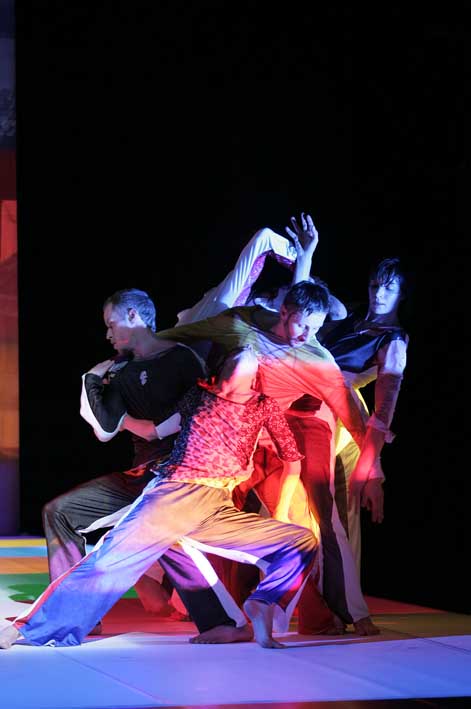
modify
Featuring free improvisation within strict boundaries, a baroque sound track and sets in acid colours, Modify asserts a personal and refined vision of dance. It is a show-kaleidoscope where the wealth of expression found in movement is celebrated during an hour of unbridled transformation
Modify is built upon two points of departure. On the one hand, there is a quest for movement material. That quest is as open as possible and not limited by the submission to a preceding content. On the other hand, there is the will to work on the basis of existing music, imposed as an external force, with its rhythm, its melody, its harmonies… Based on that confrontation between freedom and constraint, a central theme in ZOO’s work, the shape as well as the content of the project are further developed by intuition. That tension can be perceived at all the levels of the project.
First, in the creation process: Thomas Hauert believes that intuition allows to obtain more complex and more unexpected results than a process, based on initial verbalisation. That way, the choreographer deliberately leaves his projects open, conscious that the meeting between his initiative and the other dancers will have an unforeseeable outcome. The same counts for the meaning of the performance: shape and content, choreographic material and symbolic scope all develop in a parallel way, in an organic link, and it is not really possible to say that the one has preceded the other. The sense progressively emerges from the hidden preoccupations, that find an expression in the work on the movement. For the choreographer, becoming aware of an intention does not necessarily mean that one has the capacity to put that intention into words, and it can even precede that verbalisation. One may «know» without being able to «explain».
Then comes the choreographic material: different systems were elaborated to develop movement, often suggesting the idea of forces and the confrontation between internal and external forces. E.g., one of the directions consisted in working on specific mechanics to transfer forces from one body to another. The idea was to see how six moving bodies could unite to form a new entity, using specific mechanics.
Whereas the above method implies the transfer of forces by bodies that touch each other, another method looked for the possibility of uniting the six bodies from a distance, using displacements, ruled by a certain system. That searching, already present in previous work by this company, was here given an additional development by applying a particularly complex organisation, introducing a network of threads with fixed and mobile points that link all the dancers. Inherent to the aesthetical will to create unity within diversity, an order ruled by the most complex possible laws, a coherency that can be perceived without being understood, the quest also has a very strong metaphorical meaning: the movement of each body is influenced by the others. Inside a constraining system and a whole of mutual relations, there is always room for personal initiative, for choices.
A third direction drove the group into an exploration of the tension between intuition and verbalisation. The dancers looked in all freedom for movement qualities that then received names with a descriptive value. From there on, the dancers were given several tasks, consisting of recreating and manipulating those qualities, e.g. by combining the corresponding words. Again, the quest starts from the principle that the body as improvisation tool allows a much higher complexity than fixed movements, limited by the brain’s capacity of verbalising and understanding. And here again we find Thomas Hauert’s central conviction that the body is not always a person, but that it can also be used as a neutral tool, a vocabulary, to transmit a certain meaning. Far from theatrality, it is not the individual that communicates, but the body itself.
The meaning that is hidden behind this fundamental quest for movement and the method to elaborate the spectacle is extended to the other scenic elements. The music chosen is from Alfred Schnittke, Psalms of Repentence and Georg Friedrich Haendel, Music for the Royal Fireworks and Water Music. The pieces were chosen for their intrinsic musical quality, their beauty, but also for their symbolic scope. The first piece could evoke the religious power, the others the secular power, exercised on our Western civilisation. The photography on the background is by the artist Manon De Boer, forming the set, represents a room. The bed, place of the most intimate and at the same time the most existential experiences, is in contrast with the heaps of objects gathered as souvenirs during our lives.
The photography, visually chaotic and bigger than nature, the music, very imposing for a platform with six dancers, the lighting by Jan Van Gijsel and the costumes designed by Jeremy Dhennin and Laurent Edmond, combine to create a baroque abundance of sensations, aimed at drowning the spectator in information, desorientating him, overwhelming his mental capacity and inviting him to approach the work in a more intuitive way.
Modify received the Swiss Dance Prize 2005.
Concept & direction Thomas Hauert
Dance created and presented by Thomas Hauert, Lisa Gunstone, Martin Kilvady, Sara Ludi, Chrysa Parkinson, Mat Voorter
Originally created by Thomas Hauert, Martin Kilvady, Mark Lorimer, Sara Ludi, Chrysa Parkinson, Ursula Robb
Music Alfred Schnittke, Georg Friedrich Haendel, Aliocha Van der Avoort
Lighting Jan Van Gijsel
Visual Manon de Boer
Costumes Laurent Edmond, Jeremy Dhennin
Technique Jan Van Gijsel, Herman Venderickx
Production ZOO/Thomas Hauert
Coproduction: Théâtre de la Ville – Paris (FR) / Kaaitheater – Brussels (BE) / Tanzquartier – Vienna (AT)
With the support of the Government of Flanders / Vlaamse Gemeenschapscommissie / Pro Helvetia / Ein Kulturengagement des Lotterie-Fonds des Kantons Solothurn and SACD (program 1500 hours to dance)
Thanks to STUK Leuven, PARTS, Rosas, Needcompany, Ultima Vez, Thierry Lewyllie, Mark Leys, Denis Laurent, Mat Voorter, Samantha van Wissen, Pascale Gigon



